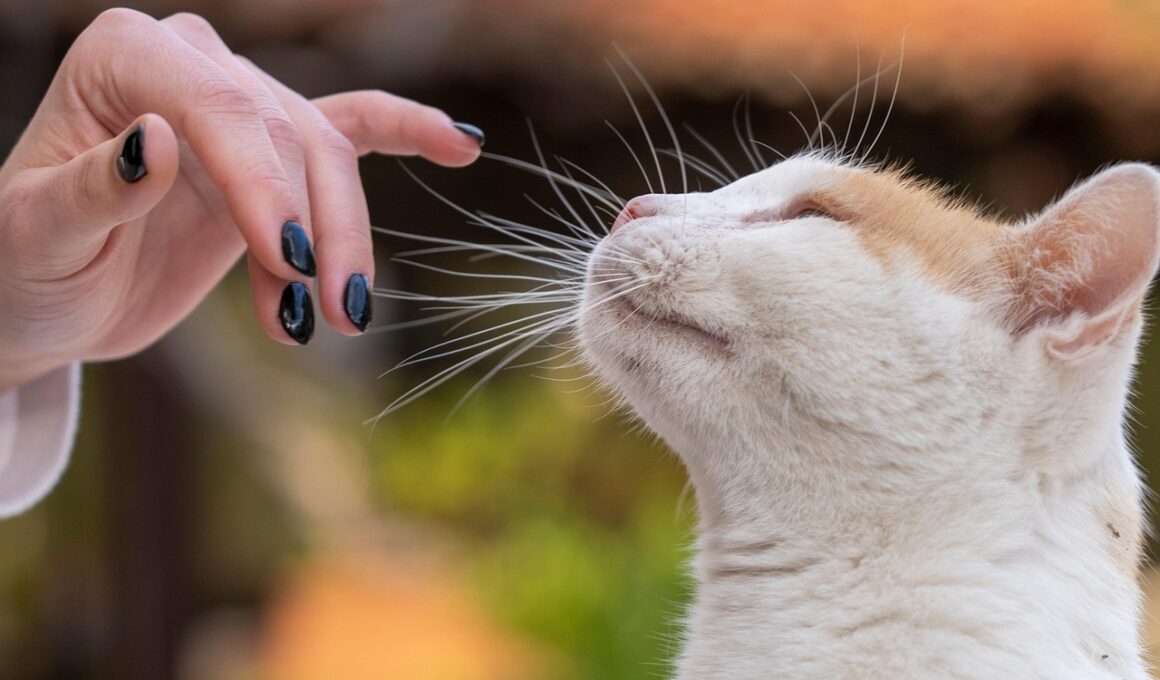Human Handling and Its Effects on Cat Trust Building
Human interaction plays a crucial role in shaping a cat’s behavior and trust toward people. When cats are handled gently and positively, they are more likely to form bonds with humans. Trust building is a process that requires patience and consistency. Each positive interaction reinforces a cat’s comfort and reduces anxiety. Establishing a safe environment for cats during handling can lead to healthier human-cat relationships. Understanding cat body language is essential in identifying when a cat is comfortable or stressed. Signs of comfort include purring, slow blinking, and a relaxed posture. Conversely, a hesitant cat may hiss, swat, or show its claws. Owners should ensure they approach their cats calmly, allowing the animal to make the first move. Offering treats during handling can also enhance the trust-building process. Additionally, avoiding forceful restraint or loud noises will help create a positive atmosphere. In turn, a trusting cat will become more affectionate and sociable. This willingness to engage with people can vastly improve the cat’s quality of life and the owner’s experience. The impact of human handling is profound and deeply interconnected with cats’ emotional well-being.
Effective communication is essential in building trust with cats during interactions. Cats are sensitive creatures with unique personalities and varying comfort levels. Therefore, it is important for owners to learn how to effectively communicate their intentions to their feline friends. Using a soft voice, gentle gestures, and slow movements can help convey calmness and reassurance. Over time, the cat will begin to associate these positive cues with a sense of safety. Regular handling sessions that are short and enjoyable will also aid in fostering trust. Gradual introduction to handling techniques allows cats to acclimate to human touch without fear. Positive reinforcement, such as treats or praise, can motivate cats to accept handling more willingly. Frequent bonding activities like playtime can establish a robust connection, making future interactions smoother. Additionally, respecting a cat’s boundaries is fundamental; forcing interaction may lead to fear and mistrust. Trust-building is an ongoing journey, sometimes taking months or years depending on the cat’s past experiences. Continuous learning about each cat’s individual preferences opens avenues for deeper connections. This nurturing approach lays the groundwork for greater emotional resilience in both cats and their human companions.
The Role of Play in Trust Building
Play is an integral aspect of bonding with cats and pivotal in trust building. Engaging in interactive play sessions effectively allows owners to connect with their cats. Utilizing toys that mimic prey, such as feather wands or toy mice, can awaken a cat’s natural hunting instincts. This type of engagement not only provides physical exercise but also mental stimulation, making the experience enjoyable for both the owner and the cat. Through play, cats learn that humans can be sources of fun rather than fear or anxiety. Furthermore, play serves as an opportunity for owners to observe their cat’s behavior, enhancing understanding of their likes and dislikes. Recognizing these preferences can lead to a more tailored approach in future handling interactions. Ensuring that play is gentle, safe, and free from overwhelming stimuli is key to maintaining trust. Establishing a routine that integrates playtime into the cat’s daily schedule reinforces familiarity and anticipation. Owners who actively participate in their cat’s play demonstrate care and attention, crucial in cementing the bond. Ultimately, play becomes a powerful tool in building trust and enriching the emotional landscape of human-feline relationships.
Incorporating grooming into the trust-building process is another vital aspect of human interaction with cats. Many cats enjoy grooming and find it to be a soothing experience. Brushing and petting can promote relaxation while providing essential physical contact. Regular grooming sessions teach cats to accept touch and can decrease anxiety surrounding human interaction. Owners should use soft brushes and gentle strokes to create a pleasant experience. Starting with short grooming sessions helps gradually condition a cat to accept longer periods. If a cat shows signs of discomfort during grooming, it is crucial to respect their limits to prevent negative associations. Positive reinforcement throughout the grooming process encourages the cat to enjoy being handled. Pairing grooming with playful interactions can foster an environment of trust. Moreover, understanding the cat’s unique grooming preferences can facilitate smoother sessions and enhance the bond. Introduce various brushes or combs to discover what your cat enjoys most. This attentive approach builds an understanding that contributes to a more connected relationship. Grooming reinforces the idea of humans providing care, ultimately leading to deeper trust and emotional security for the cat.
Understanding Cat Body Language
To enhance communication during handling, owners must understand cat body language. Cats communicate their feelings and states of mind through various expressions and movements. For instance, a cat’s tail position often indicates its mood; an upright tail signifies confidence, while a low tail may signal fear or submission. Observing ear and eye movements can also provide insight into a cat’s comfort level. Ears facing forward show curiosity, while flattened ears indicate distress. Furthermore, slow blinking can represent trust and affection. Taking the time to learn these signals allows owners to adjust their handling techniques accordingly, fostering a safe space for the cat. When a cat feels safe, it becomes more responsive to human interaction. Body language hints can guide owners on when to approach or withdraw during handling. Recognizing when a cat is overstimulated is crucial; understanding when to stop interaction can prevent negative experiences. The deeper one understands these visual cues, the better the handling experience can be tailored to each individual cat. Effective communication through body language builds a strong foundation of trust, leading to smoother and more enjoyable handling experiences for both cat and owner.
The long-term benefits of trust-building through human interaction yield profound results for both cats and their owners. Cats that develop strong bonds with humans often exhibit less anxiety and stress, resulting in healthier overall behavior. Trusting cats tend to engage more in social interactions, whether with humans or other pets, enriching their life experiences. These emotional connections can lead to a reduction in behavioral issues, such as aggression or inappropriate elimination. Additionally, a trusting cat fosters a peaceful household environment. The ease of interaction improves the daily routines of both the cat and its owner, making shared moments more enjoyable. Regular positive handling experiences enhance the cat’s adaptability to various situations, such as veterinary visits or travel. Owners will find that fostering a trusting relationship leads to a deeper emotional bond, characterized by affection and companionship. As trust builds, the cat becomes more likely to seek comfort and attention from its owner. Ultimately, the investment in time and care during handling can transform a cat into a loving and devoted companion, enriching both human and feline lives in the process. The ripple effects of trust can reverberate throughout the relationship, creating a joyful partnership.
Conclusion
In conclusion, human interaction significantly shapes a cat’s ability to build trust. Engaging with cats through gentle handling, play, and grooming plays a critical role in creating lasting bonds. By being attentive to a cat’s body language, owners can effectively foster environments where trust thrives. Understanding that each cat has unique preferences and comfort levels is paramount in this journey. Play and grooming are not just enjoyable activities but essential elements in nurturing emotional connections. As cats learn to trust their human companions, they become more sociable and interactive, enhancing their overall quality of life. This journey requires patience and consistency, but the rewards are immeasurable. The deeper emotional resilience developed through this trust not only benefits the cats but enriches the lives of their owners. Building trust through human interaction is a rewarding commitment that fosters a loving relationship. Ultimately, the journey of trust forms the foundation of joyous and fulfilling companionship, ensuring that both cats and their humans thrive together.
Comprehending the impact of human handling on cat trust is a continuous adventure. Observing and adapting to a cat’s responses can lead to deeper insights regarding their emotional states. As the journey of trust unfolds, it’s crucial for owners to remain patient and compassionate, recognizing that every cat progresses at their own pace. Frequent engagement and positive experiences reinforce trust over time. Understanding that negative experiences can set back this trust-building process is paramount, requiring owners to remain vigilant and consistent in their interactions. The significance of cultivating a nurturing atmosphere cannot be overstated; it inherently impacts the emotional well-being of both the cat and owner. As cats grow in trust, they transform into affectionate companions, enriching the lives of those around them. Owners who commit to this journey find deeper bonds formed based on mutual respect and understanding. Cats, known for their independence, also crave connection and companionship, and through careful handling, they learn the value of trust. Remember that the goal is not only to establish a bond but also to enhance the overall quality of life for both cat and human. Emphasizing compassion ultimately leads to a harmonious existence together.


